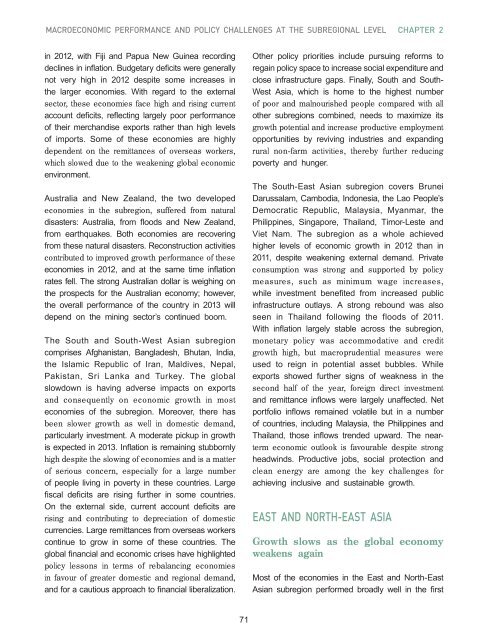Full Report - Subregional Office for East and North-East Asia - escap
Full Report - Subregional Office for East and North-East Asia - escap
Full Report - Subregional Office for East and North-East Asia - escap
Create successful ePaper yourself
Turn your PDF publications into a flip-book with our unique Google optimized e-Paper software.
MACROECONOMIC PERFORMANCE AND POLICY CHALLENGES AT THE SUBREGIONAL LEVEL CHAPTER 2<br />
in 2012, with Fiji <strong>and</strong> Papua New Guinea recording<br />
declines in inflation. Budgetary deficits were generally<br />
not very high in 2012 despite some increases in<br />
the larger economies. With regard to the external<br />
sector, these economies face high <strong>and</strong> rising current<br />
account deficits, reflecting largely poor per<strong>for</strong>mance<br />
of their merch<strong>and</strong>ise exports rather than high levels<br />
of imports. Some of these economies are highly<br />
dependent on the remittances of overseas workers,<br />
which slowed due to the weakening global economic<br />
environment.<br />
Australia <strong>and</strong> New Zeal<strong>and</strong>, the two developed<br />
economies in the subregion, suffered from natural<br />
disasters: Australia, from floods <strong>and</strong> New Zeal<strong>and</strong>,<br />
from earthquakes. Both economies are recovering<br />
from these natural disasters. Reconstruction activities<br />
contributed to improved growth per<strong>for</strong>mance of these<br />
economies in 2012, <strong>and</strong> at the same time inflation<br />
rates fell. The strong Australian dollar is weighing on<br />
the prospects <strong>for</strong> the Australian economy; however,<br />
the overall per<strong>for</strong>mance of the country in 2013 will<br />
depend on the mining sector’s continued boom.<br />
The South <strong>and</strong> South-West <strong>Asia</strong>n subregion<br />
comprises Afghanistan, Bangladesh, Bhutan, India,<br />
the Islamic Republic of Iran, Maldives, Nepal,<br />
Pakistan, Sri Lanka <strong>and</strong> Turkey. The global<br />
slowdown is having adverse impacts on exports<br />
<strong>and</strong> consequently on economic growth in most<br />
economies of the subregion. Moreover, there has<br />
been slower growth as well in domestic dem<strong>and</strong>,<br />
particularly investment. A moderate pickup in growth<br />
is expected in 2013. Inflation is remaining stubbornly<br />
high despite the slowing of economies <strong>and</strong> is a matter<br />
of serious concern, especially <strong>for</strong> a large number<br />
of people living in poverty in these countries. Large<br />
fiscal deficits are rising further in some countries.<br />
On the external side, current account deficits are<br />
rising <strong>and</strong> contributing to depreciation of domestic<br />
currencies. Large remittances from overseas workers<br />
continue to grow in some of these countries. The<br />
global financial <strong>and</strong> economic crises have highlighted<br />
policy lessons in terms of rebalancing economies<br />
in favour of greater domestic <strong>and</strong> regional dem<strong>and</strong>,<br />
<strong>and</strong> <strong>for</strong> a cautious approach to financial liberalization.<br />
Other policy priorities include pursuing re<strong>for</strong>ms to<br />
regain policy space to increase social expenditure <strong>and</strong><br />
close infrastructure gaps. Finally, South <strong>and</strong> South-<br />
West <strong>Asia</strong>, which is home to the highest number<br />
of poor <strong>and</strong> malnourished people compared with all<br />
other subregions combined, needs to maximize its<br />
growth potential <strong>and</strong> increase productive employment<br />
opportunities by reviving industries <strong>and</strong> exp<strong>and</strong>ing<br />
rural non-farm activities, thereby further reducing<br />
poverty <strong>and</strong> hunger.<br />
The South-<strong>East</strong> <strong>Asia</strong>n subregion covers Brunei<br />
Darussalam, Cambodia, Indonesia, the Lao People’s<br />
Democratic Republic, Malaysia, Myanmar, the<br />
Philippines, Singapore, Thail<strong>and</strong>, Timor-Leste <strong>and</strong><br />
Viet Nam. The subregion as a whole achieved<br />
higher levels of economic growth in 2012 than in<br />
2011, despite weakening external dem<strong>and</strong>. Private<br />
consumption was strong <strong>and</strong> supported by policy<br />
measures, such as minimum wage increases,<br />
while investment benefited from increased public<br />
infrastructure outlays. A strong rebound was also<br />
seen in Thail<strong>and</strong> following the floods of 2011.<br />
With inflation largely stable across the subregion,<br />
monetary policy was accommodative <strong>and</strong> credit<br />
growth high, but macroprudential measures were<br />
used to reign in potential asset bubbles. While<br />
exports showed further signs of weakness in the<br />
second half of the year, <strong>for</strong>eign direct investment<br />
<strong>and</strong> remittance inflows were largely unaffected. Net<br />
portfolio inflows remained volatile but in a number<br />
of countries, including Malaysia, the Philippines <strong>and</strong><br />
Thail<strong>and</strong>, those inflows trended upward. The nearterm<br />
economic outlook is favourable despite strong<br />
headwinds. Productive jobs, social protection <strong>and</strong><br />
clean energy are among the key challenges <strong>for</strong><br />
achieving inclusive <strong>and</strong> sustainable growth.<br />
EAST AND NORTH-EAST ASIA<br />
Growth slows as the global economy<br />
weakens again<br />
Most of the economies in the <strong>East</strong> <strong>and</strong> <strong>North</strong>-<strong>East</strong><br />
<strong>Asia</strong>n subregion per<strong>for</strong>med broadly well in the first<br />
71












